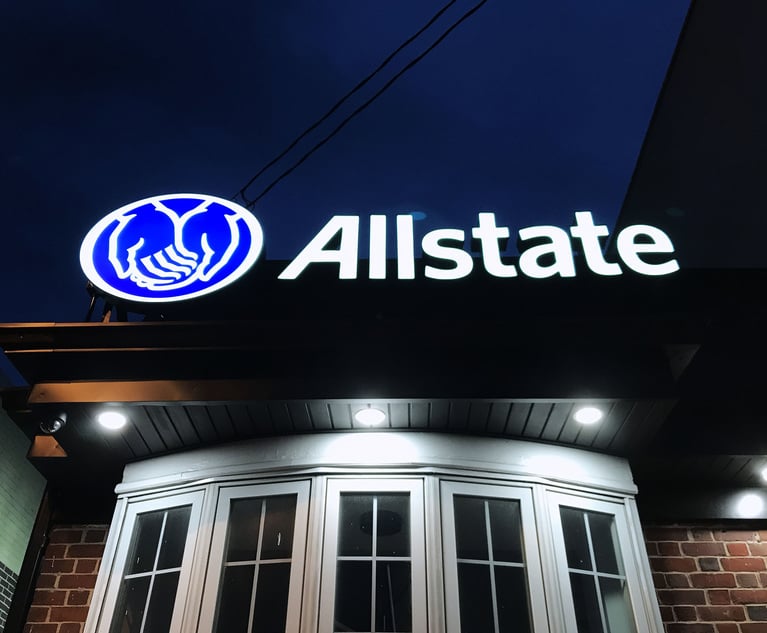Bankruptcy in the Age of COVID-19: Evaluate Financial Distress
With new realities, bankruptcy practitioner Frank Eaton says the legal system is up to the task of responding to the most challenging economic times faced by the United States in several generations.
March 27, 2020 at 12:05 PM
9 minute read
 Frank Eaton, Linda Leali P.A.
Frank Eaton, Linda Leali P.A.
A worldwide pandemic of the proportion of the COVID-19 virus has not been seen since the Spanish Flu of 1918.
Over 100 years later, the United States is a much different place with a population of 331 million compared to 103 million in 1918, and transportation, communication, manufacturing and social networking systems that connect practically every point on the globe and form the basis of our complex and intertwined world economy.
The first documented real (i.e., inflation-adjusted) gross domestic product for the United States in 1929 was $1.11 trillion as compared in $19.1 trillion in 2019. The advances in technology, medicine, transportation and manufacturing since 1918 have been breathtaking.
Notwithstanding the advances in medicine over the past century, many of the same fears and concerns exist today as existed in 1918.
There is little disagreement among economists that our co-dependent world economy has and will be severely impacted by the COVID-19 virus for months and maybe years to come. The attack of the virus has had a devastating cross-border domino effect impacting virtually every sector of the world economy.
The airline, cruise and retail industries have suffered a staggering blow. The still-recovering energy sector is being savaged again by deflated prices emanating from Saudi Arabia's influence and lack of demand. The real estate market has been chilled with uncertainty. The automotive and technology sectors are already being impacted by a disruption in supply chains, slowing demand and some curtailed operations. The entertainment sector, which includes restaurants, movie theaters, music and sports venues, and museums, has practically ground to a halt. Big-box retailers and mom-and-pop stores alike are cutting back hours or are closed on a temporary basis, and many anticipate a drop in business after a return to some normalcy.
Consumer spending will be negatively impacted due in part to terminated or furloughed employees, some or most without pay or benefits, or even a modest safety net. Even employees who are continuing to receive pay and benefits and consumers with savings may not be inclined to spend in the same fashion as they did prior to the COVID-19 virus given the uncertainty about the future of the economy or even a resurgence of the virus. To make matters worse, the continued decline in the stock market will further negatively impact consumer spending in every sector.
And lastly, the changes to the workplace will have a detrimental impact on productivity. Though employees of some service industries may be able to work from home, manufacturing, construction and many other industries depend upon an onsite workforce.
Unemployment is certain to rise. Notwithstanding the initial economic stimulus package, the economy has received a body blow with an uncertain horizon for recovery. All of this is a recipe for economic disaster for both large and small businesses in the United States.
Navigating Recovery
With all of this doom and gloom, the bankruptcy bar is anticipating a substantial increase in the need for the services of bankruptcy practitioners. I say this not to suggest that the bankruptcy bar will profit from an economic disaster, but to suggest that bankruptcy professionals will be critical in helping navigate a recovery. While the top-tier law firms are well-positioned to handle the largest Chapter 11 cases, smaller law firms should prepare to proactively address the crisis by reaching out to clients to both plan for, and respond to, the new realities.
Most commercial bankruptcy practitioners know the drill. Under the current environment, counsel should arrange a telephonic or video conference with their clients to conduct an overall evaluation of individual client's business and any potential sources of financial distress.
Although the COVID-19 pandemic will directly affect many businesses, the indirect effects of the pandemic will be far more extensive. The circumstances and sources of financial stress will vary from industry to industry. Some clients will have concerns about potentially becoming insolvent because of reduced demand for their products or services, or their inability to produce their products or services, and others will have concerns because they are creditors of companies in distress.
As I write this, many companies are scouring their contracts to determine the extent to which force majeure provisions have been triggered to excuse performance. Many others are reviewing their insurance coverage. Bankruptcy counsel should explain to clients that they understand that these are very difficult and stressful times, and that they are available to provide strategic advice and planning. If a company has not retained restructuring counsel, counsel should be in a position to recommend a firm that can provide appropriate advice.
Clients at this point may have many questions: How do we anticipate what is about to unfold? Which creditors should we pay first? What proactive actions can we undertake to maintain the solvency of our business? These questions involve not only bankruptcy and insolvency concerns, but also involve corporate and contract matters, employment law, litigation and other legal practices.
The first course of action for bankruptcy counsel advising a client is to determine whether any of the recent COVID-19 legislation protects or affects the client's business. Although legislation has been proposed to protect the airline and cruise industries and small businesses and to provide some assistance to consumers, the exact parameters of such protection and the implications to the client, need to be considered.
The second course of action is to consider approaching lenders, suppliers, landlords and other creditors to possibly renegotiate the terms of existing agreements or, if the client is at risk of contract default, to discuss a standstill agreement. In order to keep loans performing, lenders may be amenable to debt refinancing, though the full disclosure that lenders will require regarding a borrower's financial condition may suggest caution in pursuing this approach. Among other things, unsecured lenders may insist on security or guarantees as a condition of going forward, and because of the potential impairment of the value of company assets, may require significant overcollateralization.
The case with suppliers, who may also be in financial distress, is different than with manufacturers, since suppliers often factor their receivables, and customers' failure to pay puts them at substantial risk. Accordingly, suppliers may refuse to supply further goods or services to nonpaying or slow-paying customers, which will put a manufacturing company in further jeopardy.
Landlords may also be unwilling to renegotiate leases or to enter into standstill agreements, especially those having mortgages on the company's property. Indeed, the suppliers and landlords may also be considering seeking bankruptcy protection, which would create a scenario called "dueling bankruptcy cases," where each debtor has similar rights and protections under the Bankruptcy Code.
If a standstill agreement cannot be negotiated with the company's principal creditors, there are at least three options for a company in distress: reorganization or liquidation under Chapter 11 of the Bankruptcy Code, where the company remains in control of the process under Bankruptcy Court supervision; liquidation under Chapter 7 of the Bankruptcy Code, where a trustee assumes control of the process under Bankruptcy Court supervision; or an assignment for the benefit of creditors, which is a liquidation proceeding conducted under state law by an assignee of the company's assets.
An enterprise or asset sale can be accomplished under each of these procedures, although most professionals will suggest a controlled sale process under Chapter 11, which can maximize the return to creditors by permitting sales to be free and clear of liens, claims and encumbrances. In addition, one of the primary protections for companies under the Bankruptcy Code is the automatic stay, which enjoins creditors under most circumstances from taking immediate action against a company and provides breathing room for either a reorganization or an orderly liquidation.
The first gating issue for counsel and the client is to examine whether a company in financial distress should reorganize or liquidate. There are numerous factors to be considered: does the company have cash reserves to fund a reorganization or access to post-bankruptcy financing; does the company have a business plan in place that contemplates a short or medium-term financial downturn, with the expectation that the economy will at some point return to normalcy; does the company have the support of lenders and creditors for a reorganization?
In addition, counsel should identify the company's key creditors, including lenders, suppliers and landlords, and determine whether the client is current with its debt servicing and payables. In most cases, a company in financial distress will be out of compliance on its loan covenants and behind on its payables.
If the company, in consultation with its board of directors or managers, counsel and financial advisers, believes that it has the financial wherewithal to reorganize, then it should proceed under Chapter 11. Briefly, Chapter 11 contemplates that the client will file a plan of reorganization which will provide that the company will pay creditors a percentage dollar amount on their claims. The Chapter 11 plan is subject to creditor approval and confirmation by a bankruptcy judge. Counsel will need to calculate the company's assets in order to determine the client's eligibility to file for reorganization. A company that has noncontingent, liquidated debts (secured and unsecured) less than $2,725,625 would be required to file under Bankruptcy Code's new Small Business Reorganization Act.
If the company's decision is to liquidate, it can proceed under Chapter 11 to conduct an orderly liquidation controlled by the company, which would typically provide for the sale of the company's assets, with the net proceeds distributed to creditors under a liquidation plan approved by creditors and confirmed by a bankruptcy judge.
The other alternative is a complete cessation of operations under Chapter 7 where a third-party trustee is appointed to investigate the affairs of the company, liquidate assets and distribute the net proceeds, if any, to creditors in accordance with the distribution provisions of the Bankruptcy Code.
The third alternative is liquidation pursuant to an assignment for the benefit of creditors in state court. The proceeding is analogous to a bankruptcy liquidation under Chapter 7 of the Bankruptcy Code. The assignment is a contract, in which the company as assignor turns over all assets to an assignee, who is charged with the liquidation of assets for the benefit of creditors.
In conclusion, what we are experiencing may well be the most challenging economic times faced by the United States in several generations. As a nation, we have a legal system up to the task of responding to the impending crisis in a rational and orderly manner, and a judiciary and restructuring professionals well-equipped to address the current economic downturn and assist companies in financial distress.
Frank L. Eaton is of counsel to Linda Leali P.A., a boutique law firm in Pompano Beach that specializes in bankruptcy, receivership and business law. He has over 30 years of experience as a restructuring lawyer and has represented debtors and creditors in bankruptcy cases.
This content has been archived. It is available through our partners, LexisNexis® and Bloomberg Law.
To view this content, please continue to their sites.
Not a Lexis Subscriber?
Subscribe Now
Not a Bloomberg Law Subscriber?
Subscribe Now
NOT FOR REPRINT
© 2025 ALM Global, LLC, All Rights Reserved. Request academic re-use from www.copyright.com. All other uses, submit a request to [email protected]. For more information visit Asset & Logo Licensing.
You Might Like
View All
Plaintiffs Attorneys Awarded $113K on $1 Judgment in Noise Ordinance Dispute
4 minute read
US Judge Cannon Blocks DOJ From Releasing Final Report in Trump Documents Probe
3 minute read

Read the Document: DOJ Releases Ex-Special Counsel's Report Explaining Trump Prosecutions
3 minute readTrending Stories
- 1Uber Files RICO Suit Against Plaintiff-Side Firms Alleging Fraudulent Injury Claims
- 2The Law Firm Disrupted: Scrutinizing the Elephant More Than the Mouse
- 3Inherent Diminished Value Damages Unavailable to 3rd-Party Claimants, Court Says
- 4Pa. Defense Firm Sued by Client Over Ex-Eagles Player's $43.5M Med Mal Win
- 5Losses Mount at Morris Manning, but Departing Ex-Chair Stays Bullish About His Old Firm's Future
Who Got The Work
J. Brugh Lower of Gibbons has entered an appearance for industrial equipment supplier Devco Corporation in a pending trademark infringement lawsuit. The suit, accusing the defendant of selling knock-off Graco products, was filed Dec. 18 in New Jersey District Court by Rivkin Radler on behalf of Graco Inc. and Graco Minnesota. The case, assigned to U.S. District Judge Zahid N. Quraishi, is 3:24-cv-11294, Graco Inc. et al v. Devco Corporation.
Who Got The Work
Rebecca Maller-Stein and Kent A. Yalowitz of Arnold & Porter Kaye Scholer have entered their appearances for Hanaco Venture Capital and its executives, Lior Prosor and David Frankel, in a pending securities lawsuit. The action, filed on Dec. 24 in New York Southern District Court by Zell, Aron & Co. on behalf of Goldeneye Advisors, accuses the defendants of negligently and fraudulently managing the plaintiff's $1 million investment. The case, assigned to U.S. District Judge Vernon S. Broderick, is 1:24-cv-09918, Goldeneye Advisors, LLC v. Hanaco Venture Capital, Ltd. et al.
Who Got The Work
Attorneys from A&O Shearman has stepped in as defense counsel for Toronto-Dominion Bank and other defendants in a pending securities class action. The suit, filed Dec. 11 in New York Southern District Court by Bleichmar Fonti & Auld, accuses the defendants of concealing the bank's 'pervasive' deficiencies in regards to its compliance with the Bank Secrecy Act and the quality of its anti-money laundering controls. The case, assigned to U.S. District Judge Arun Subramanian, is 1:24-cv-09445, Gonzalez v. The Toronto-Dominion Bank et al.
Who Got The Work
Crown Castle International, a Pennsylvania company providing shared communications infrastructure, has turned to Luke D. Wolf of Gordon Rees Scully Mansukhani to fend off a pending breach-of-contract lawsuit. The court action, filed Nov. 25 in Michigan Eastern District Court by Hooper Hathaway PC on behalf of The Town Residences LLC, accuses Crown Castle of failing to transfer approximately $30,000 in utility payments from T-Mobile in breach of a roof-top lease and assignment agreement. The case, assigned to U.S. District Judge Susan K. Declercq, is 2:24-cv-13131, The Town Residences LLC v. T-Mobile US, Inc. et al.
Who Got The Work
Wilfred P. Coronato and Daniel M. Schwartz of McCarter & English have stepped in as defense counsel to Electrolux Home Products Inc. in a pending product liability lawsuit. The court action, filed Nov. 26 in New York Eastern District Court by Poulos Lopiccolo PC and Nagel Rice LLP on behalf of David Stern, alleges that the defendant's refrigerators’ drawers and shelving repeatedly break and fall apart within months after purchase. The case, assigned to U.S. District Judge Joan M. Azrack, is 2:24-cv-08204, Stern v. Electrolux Home Products, Inc.
Featured Firms
Law Offices of Gary Martin Hays & Associates, P.C.
(470) 294-1674
Law Offices of Mark E. Salomone
(857) 444-6468
Smith & Hassler
(713) 739-1250






